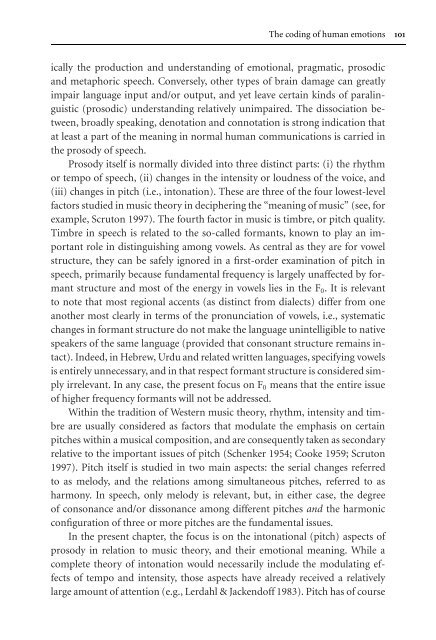Tone of Voice and Mind : The Connections between Intonation ...
Tone of Voice and Mind : The Connections between Intonation ...
Tone of Voice and Mind : The Connections between Intonation ...
Create successful ePaper yourself
Turn your PDF publications into a flip-book with our unique Google optimized e-Paper software.
<strong>The</strong> coding <strong>of</strong> human emotions 101<br />
ically the production <strong>and</strong> underst<strong>and</strong>ing <strong>of</strong> emotional, pragmatic, prosodic<br />
<strong>and</strong> metaphoric speech. Conversely, other types <strong>of</strong> brain damage can greatly<br />
impair language input <strong>and</strong>/or output, <strong>and</strong> yet leave certain kinds <strong>of</strong> paralinguistic<br />
(prosodic) underst<strong>and</strong>ing relatively unimpaired. <strong>The</strong> dissociation <strong>between</strong>,<br />
broadly speaking, denotation <strong>and</strong> connotation is strong indication that<br />
at least a part <strong>of</strong> the meaning in normal human communications is carried in<br />
the prosody <strong>of</strong> speech.<br />
Prosody itself is normally divided into three distinct parts: (i) the rhythm<br />
or tempo <strong>of</strong> speech, (ii) changes in the intensity or loudness <strong>of</strong> the voice, <strong>and</strong><br />
(iii) changes in pitch (i.e., intonation). <strong>The</strong>se are three <strong>of</strong> the four lowest-level<br />
factors studied in music theory in deciphering the “meaning <strong>of</strong> music” (see, for<br />
example, Scruton 1997). <strong>The</strong> fourth factor in music is timbre, or pitch quality.<br />
Timbre in speech is related to the so-called formants, known to play an important<br />
role in distinguishing among vowels. As central as they are for vowel<br />
structure, they can be safely ignored in a first-order examination <strong>of</strong> pitch in<br />
speech, primarily because fundamental frequency is largely unaffected by formant<br />
structure <strong>and</strong> most <strong>of</strong> the energy in vowels lies in the F0. Itisrelevant<br />
to note that most regional accents (as distinct from dialects) differ from one<br />
another most clearly in terms <strong>of</strong> the pronunciation <strong>of</strong> vowels, i.e., systematic<br />
changes in formant structure do not make the language unintelligible to native<br />
speakers <strong>of</strong> the same language (provided that consonant structure remains intact).<br />
Indeed, in Hebrew, Urdu <strong>and</strong> related written languages, specifying vowels<br />
is entirely unnecessary, <strong>and</strong> in that respect formant structure is considered simply<br />
irrelevant. In any case, the present focus on F0 means that the entire issue<br />
<strong>of</strong> higher frequency formants will not be addressed.<br />
Within the tradition <strong>of</strong> Western music theory, rhythm, intensity <strong>and</strong> timbre<br />
are usually considered as factors that modulate the emphasis on certain<br />
pitches within a musical composition, <strong>and</strong> are consequently taken as secondary<br />
relative to the important issues <strong>of</strong> pitch (Schenker 1954; Cooke 1959; Scruton<br />
1997). Pitch itself is studied in two main aspects: the serial changes referred<br />
to as melody, <strong>and</strong> the relations among simultaneous pitches, referred to as<br />
harmony. In speech, only melody is relevant, but, in either case, the degree<br />
<strong>of</strong> consonance <strong>and</strong>/or dissonance among different pitches <strong>and</strong> the harmonic<br />
configuration <strong>of</strong> three or more pitches are the fundamental issues.<br />
In the present chapter, the focus is on the intonational (pitch) aspects <strong>of</strong><br />
prosody in relation to music theory, <strong>and</strong> their emotional meaning. While a<br />
complete theory <strong>of</strong> intonation would necessarily include the modulating effects<br />
<strong>of</strong> tempo <strong>and</strong> intensity, those aspects have already received a relatively<br />
large amount <strong>of</strong> attention (e.g., Lerdahl & Jackend<strong>of</strong>f 1983). Pitch has <strong>of</strong> course


